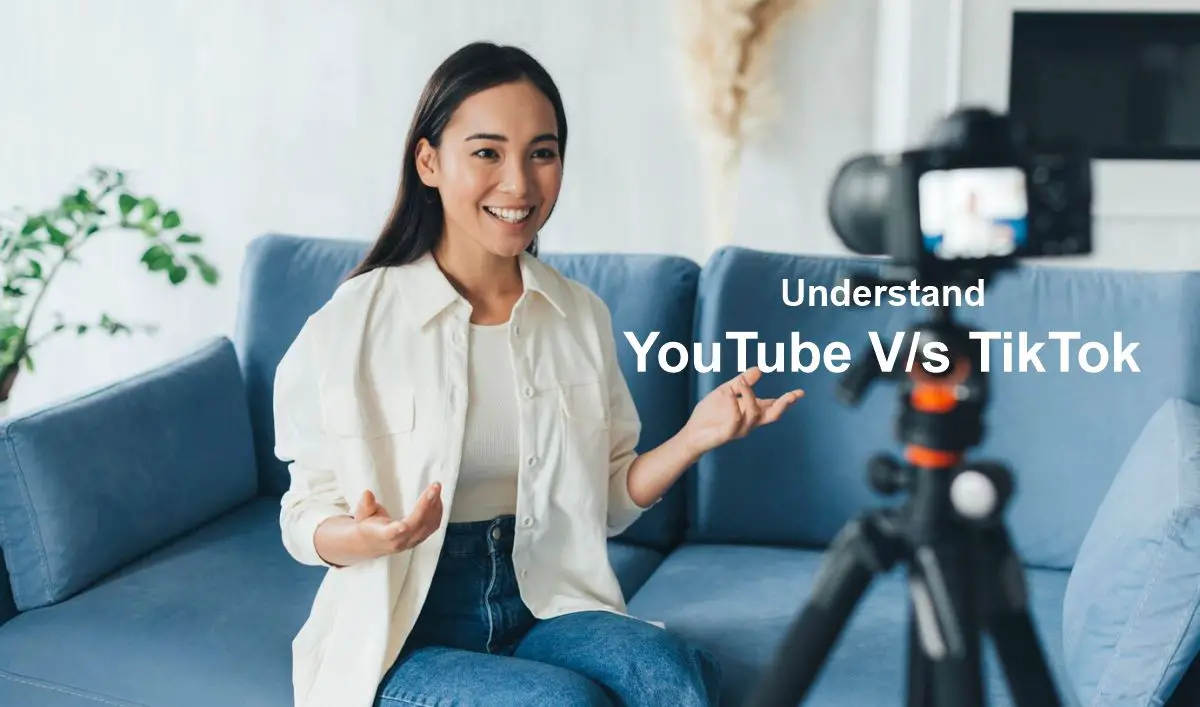Key Takeaways
- YouTube dominates in long-form, searchable content and long-term monetization potential.
- TikTok thrives on short-form, trend-based discovery and offers rapid audience growth.
- Choosing between them depends on your content goals, target audience, production capabilities, and business strategy.
In the era of digital dominance, content creators and businesses are often faced with a critical question: Should I focus on YouTube or TikTok? While both platforms are powerhouses in the video content world, they serve very different purposes and reward different approaches.
YouTube, the longstanding king of video content, excels at nurturing deep viewer relationships over time. In contrast, TikTok is the poster child of viral culture, where creativity and speed can catapult creators to instant fame. If you’re serious about video marketing or building a content empire, understanding how these platforms differ will help you choose—or balance—your strategy wisely.
YouTube vs. TikTok: Core Differences Explained

Although both platforms allow creators and brands to share video content, they are designed for fundamentally different viewer experiences. Let’s examine their primary differences through various critical lenses.
1. Content Format, Duration, and Style
YouTube: The Home of Long-Form, In-Depth Content
YouTube’s strength lies in its ability to support videos of nearly any length, making it the go-to platform for:
- Educational tutorials and deep-dive how-tos
- Product demonstrations and tech reviews
- Web series, interviews, podcasts, and vlogs
- Thought leadership, documentary-style storytelling
- Evergreen, keyword-optimized content that continues to attract viewers over time
Average Video Length: 8–30 minutes (but can be longer)
Best For: Creators who offer value through storytelling, teaching, or long-form entertainment.
YouTube rewards creators who produce high-quality, structured videos and maintain consistent publishing schedules. It also supports playlist organization, community posts, and subscriptions, all of which contribute to stronger audience loyalty.
TikTok: Short, Snappy, and Addictive
TikTok’s magic lies in its ability to grab attention within seconds. With a focus on bite-sized content, this platform is ideal for:
- Quick tutorials and life hacks
- Skits, challenges, and memes
- Product teasers or viral-style reviews
- Behind-the-scenes or day-in-the-life content
- Visual storytelling and entertainment hooks
Video Duration: 15 seconds to 3 minutes (with some creators now testing up to 10 minutes)
Best For: Creators who are fast, creative, trend-aware, and great at grabbing attention within the first few seconds.
2. Audience Demographics
Understanding who uses each platform helps align your content with your ideal viewers.
YouTube Audience Insights
- Age Range: 15–50+, with strong engagement from Gen Z, millennials, and Gen X.
- Usage: Viewers often search with intent (e.g., “how to fix a dishwasher” or “best laptops under $1000”).
- Behavior: Users are more likely to subscribe and return to creators they trust, leading to stronger long-term loyalty.
- Purpose: Learning, entertainment, product research, and hobby exploration.
TikTok Audience Insights
- Age Range: Core users are 16–34, with Gen Z dominating but millennial adoption increasing rapidly.
- Usage: Most browsing is passive—users scroll through their “For You Page” looking for entertainment or discovery.
- Behavior: Highly trend-driven, with short attention spans and frequent interactions (likes, comments, shares).
- Purpose: Casual discovery, trend participation, light learning (if fun), humor, and entertainment.
3. Monetization Opportunities
Both platforms allow creators to earn, but the monetization systems vary greatly in structure, predictability, and payout.
How YouTubers Earn
- Ad Revenue through the YouTube Partner Program (YPP): Requires 1,000 subscribers and 4,000 watch hours.
- Channel Memberships & Patreon: Offer exclusive perks for paying fans.
- Super Chats in livestreams: Fans pay to highlight comments.
- Merch Shelf Integration with platforms like Teespring.
- Affiliate Links & Sponsored Videos: High revenue potential with engaged audiences.
- YouTube Premium Payouts: Based on viewer watch time from Premium subscribers.
YouTube Pros:
- High earning potential for evergreen content
- Long shelf life: A video from 2 years ago can still generate income
- Multiple monetization streams = income diversification
How TikTokers Earn
- TikTok Creator Fund: Requires 10,000 followers and 100,000 views in 30 days.
- TikTok LIVE & Gifts: Monetize livestreams through fan donations.
- Brand Sponsorships: High-value influencer collaborations.
- TikTok Creator Marketplace: Connects creators with brands directly.
- Tipping and Product Links (limited feature access based on region/account status)
TikTok Pros:
- Fast growth = quick access to monetization
- Easier to go viral with no follower base
- Great for building a brand and driving traffic to external monetized platforms (like YouTube or websites)
4. Marketing & Brand Potential
Both platforms offer unique opportunities for brands and small businesses—but they excel in different phases of the customer journey.
YouTube for Brands
- Best for: B2B brands, SaaS companies, educational creators, and any product/service requiring explanation.
- Great for: Authority building, product tutorials, testimonials, case studies, and in-depth buyer education.
- Sales Cycle Role: Consideration and conversion stages.
- Long-Term ROI: Evergreen videos continue to drive leads and revenue months (or years) later.
TikTok for Brands
- Best for: DTC, eCommerce, fashion, food, fitness, beauty, and youth-oriented lifestyle products.
- Great for: Brand awareness, viral challenges, influencer marketing, and community engagement.
- Sales Cycle Role: Awareness and engagement phases.
- Speed: Immediate visibility and traction when content trends.
Pro Tip: Many brands use TikTok to build awareness and then funnel that traffic to YouTube for deeper education and conversion.
5. SEO & Discoverability
One of the biggest differences between YouTube and TikTok lies in how audiences discover content.
YouTube = Search-First Platform
- Second-largest search engine (after Google).
- Discovery through:
- Keyword searches
- Suggested videos
- Channel subscriptions
- External backlinks and embeds
- Best practices: Use optimized titles, thumbnails, tags, timestamps, and descriptions.
- Longevity: Videos can rank and deliver traffic for years.
TikTok = Algorithm-First Platform
- Discovery through the “For You Page,” driven by:
- Viewer watch behavior
- Video engagement metrics
- Sound usage and trending hashtags
- Captions and posting frequency
- Lifespan: High early engagement needed; viral videos often die off in 48–72 hours.
- Best practices: Hook viewers in the first 3 seconds, use trending sounds, and post frequently.
6. Platform Challenges & Future Outlook
YouTube Challenges
- Saturated niches and high competition
- Greater time and equipment investment
- Algorithm changes that impact visibility
- Slower growth curve compared to TikTok
TikTok Challenges
- Burnout due to constant content pressure
- Volatility in reach and monetization
- Harder to build long-term loyalty
- Potential regulatory hurdles in global markets
What’s Next?
- YouTube Shorts is bridging the gap into short-form
- TikTok is testing long-form videos (up to 10 minutes)
- Both are expanding livestreaming and AI-based tools
- Cross-posting strategies and omnichannel presence are key for serious creators
Which Platform Should You Choose?
For Content Creators:
Go with YouTube if you…
- Want long-term growth and income
- Excel at teaching, storytelling, or in-depth content
- Can invest in high-quality production and consistency
- Are building a searchable content library
Go with TikTok if you…
- Want to grow fast and experiment with trends
- Prefer short, punchy content
- Have limited resources or want to test concepts quickly
- Are focused on personal branding or viral reach
For Businesses:
Choose YouTube if you…
- Have complex offerings or B2B services
- Want to build credibility and educate your audience
- Need lasting ROI from content
Choose TikTok if you…
- Sell trendy, visual, or impulse-buy products
- Are targeting younger, mobile-first audiences
- Can create authentic, entertaining video experiences
Bonus: Cross-Platform Strategy Tips
Why choose just one? Smart creators and brands leverage both:
- Use TikTok to drive awareness and grow rapidly.
- Send followers to YouTube for in-depth value and conversion.
- Repurpose YouTube clips into TikToks (and vice versa).
- Use Shorts to test topics before full-length content creation.
Frequently Asked Questions
How do I repurpose TikTok content for YouTube Shorts?
- Remove TikTok watermark using apps like SnapTik or CapCut
- Re-edit for YouTube’s slightly different aspect ratio and pacing
- Add more context in the title/description
- Use Shorts as a “highlight reel” to promote longer videos
Can I turn YouTube content into TikTok clips?
- Clip high-impact segments into 15–60 second snippets
- Add music, subtitles, and trending audio
- Create “tips series” from long tutorials
- Use audience analytics to find the best-performing segments to cut
Is TikTok better for small businesses?
Yes—especially early on. It’s easier to go viral, and organic reach is still strong. But for sustained growth and conversion, YouTube’s deeper content is critical.
Final Thoughts
The best platform isn’t necessarily either YouTube or TikTok—it’s the one that aligns with your content strengths, audience needs, and business goals. Both are powerful in different ways, and the smartest move is to understand how each fits into your broader content ecosystem.
Start where you feel most confident. Then expand.
Need help planning a dual-platform video strategy or repurposing your content across both? I’ve got your back—just say the word!

